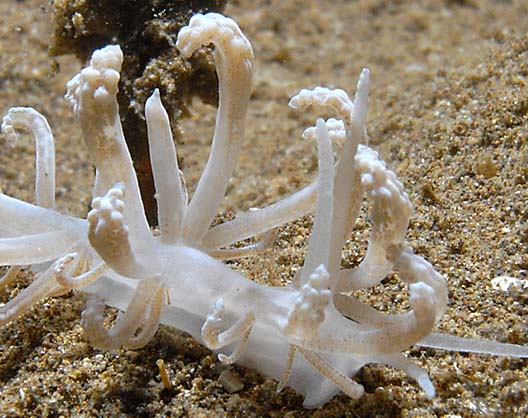| ORDER : NUDIBRANCHIA | ||||
| Suborder : AEOLIDINA | ||||
| Family : Aeolidiidae, Flabellinidae, Glaucidae and Tergipedidae | ||||
The Aeolidiidae (Gray, 1827)
All the cerata arise in regular rows from subdivisions of the digestive gland.
Propodial tentacle and long agile oral tentacles are present.
The aeolidiidae feeds primarily upon sea anemones and zoanthids. They are low-moving, aggressive aeolidaceans.
Cleioproctic anal position. Anus located laterally, approximately half-way back along the right side of the body.
Cerberilla (Bergh, 1873)
Body and mantle : The broad foot is an adaptation for crawling on sandly substrate They cannot jettison their cerata like other aeolid nudibranchs Photo : C. affinis |
 |
Behavior : Cerberilla are found in habitats where they feed on burrowing coelenterates such as cerianthids |
The Flabellinidae (Bergh, 1889)
Elongate bodies that taper posteriorly to a point. There may be a distinct notal ridge separating the dorsum from the flanks.
Cerata in even or irregular rows, sometimes clustered into groups set upon lobes or peduncles.
The rhinophores may be smooth, papillate or lamellate
Distinct propodial tentacles and long and mobile oral tentacles are conspicuous
Active aeolidaceans.
Pleuroproctic (anus on right side of the body, below level of notum or cerata) occasionally acleioproctic (anus located dorsally, to the right of the dorsal mid-line) anal position.
Flabellina (Voigt, 1834)
Characteristics : The genus flabellina is large and one of the most morphologically diverse of all the aeolids. The cerrata arrandement, shape of the rhinophores and elaboration of the anterior margin of the foot are among the most variable external characteristics. The genera Flabellina retain a pair of lateral teeth on either side of the central tooth. Photo : F. exoptata |
 |
The Glaucidae (Gray, 1827)
Favorinus (Gray, 1850)
Body and mantle : Cleioproctic anal position. Anus located laterally, within the foremost ceratal arch derived on the right side from the left digestive gland. Propodial tentacles (a) and long agile oral tentacles (b) are present.
Photo : F. mirabilis |
 |
|
Rhinophores : Favorinids having one or more bulbous swellings on the rhinophores
Photo : F. japonicus |
Behavior : Mobile, aggressive aeolidaceans. |
Phyllodesmium ( Ehrenberg, 1831 )
Characteristics : Alcyonarian-eating aeolids with readily autotomising cerata. Cerata slightly or extremely flattened, usually lacking functional cnidosacs. Cleioproctic, anus lying in first post-cardiac arch or behind first post-cardiac row or in one case above post-cardiac arch At present only known from the Indo-West Pacific
Photo : Phyllodesmium hyalinum |
 |
Glaucus ( Forster, 1777)
Characteristics : Glaucus appear to be "monotypic" genera. Only one species G.atlanticus. The main external characteristic is that in Glaucus the cerata are arranged in a single row in each arch while.
Photo : G. atlanticus |
 |
Rhinophores : Glaucus atlanticus, live in close association with what Sir Alistair Hardy described many years ago as "The Blue Fleet" ( the siphonophores such as Physalia ("Portuguese man-of-war" or "Bluebottle"), Velella, Porpita and the other associated animals including the "Violet snails" of the genus Janthina)
|
Pteraeolidia (Bergh, 1875)
Body and mantle : The purple bands on the oral tentacles are fairly distinctive. Elongated shape, with cerrata groups disposed symmetrically along all of the body Photo : P. ianthina |
 |
The Tergipedidae (Bergh, 1889)
Propodial tentacles rudimentary or absent.
Acleioproctic anal position (anus located dorsally, to the right of the dorsal mid-line)
Oral and rhinophoral tentacles smooth.
Cerata in even rows, often reduced in number, fusiform or clavate (gradually thickening near distal end)
Phestilla (Bergh, 1874)
Characteristics : Phestilla are closely related to Cuthona, but lack a sac at the tip of the cerata for storing nematocyst Photo : P. lugubris |
 |
